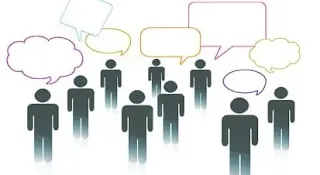In the dynamic landscape of organizational management, understanding the nuances of communication is pivotal. One of the critical avenues of this is "downward communication."Communication is the lifeblood of any organization, ensuring that everyone is on the same page and working towards common goals. Among the various types of communication processes within an organization, downward communication stands out as a critical component. Let's delve deeper into the concept, its significance, and its practical applications.
Definition of Downward Communication
Before we delve deeper, it is essential to understand what downward communication refers to. In the simplest terms, downward communication is a form of organizational communication where information flows from the top echelons of an organization to the lower levels. It is a vertical communication structure representing a top-down approach where managers, leaders, or executives convey information to the employees.
Objectives of Downward Communication
Downward communication plays a pivotal role in steering the organization towards its goals. The primary objectives of downward communication include:
- Setting goals and expectations
- Providing feedback
- Clarifying tasks and responsibilities
- Ensuring adherence to policies and procedures
- Facilitating coordination and collaboration among teams
Advantages and Disadvantages of Downward Communication
Like any form of communication, downward communication offers both pros and cons. Let's delve into them:
Advantages of Downward Communication Include:
- Clarity of Roles: Downward communication helps ensure that employees have a clear understanding of their roles and responsibilities.
- Alignment with Organizational Goals: Effective downward communication helps in aligning the workforce with the organization's objectives.
- Enhanced Productivity: Downward communication can help in enhancing productivity by providing clear instructions and feedback.
Disadvantages Include:
- Potential for Miscommunication: If not handled well, downward communication can lead to misunderstandings and misinformation.
- Limited Feedback: Downward communication typically offers limited scope for feedback from the employees.
- Risk of Over-Controlling: Excessive reliance on downward communication can also foster a culture of micromanagement, stifling innovation and initiative.
Downward Communication in the Workplace
In the workplace, downward communication is used extensively to steer the organization towards its goals. Let's explore how to make downward communication more effective in the workplace.
Creating an Open and Transparent Communication Culture
An open and transparent communication culture is vital in ensuring the effectiveness of their downward communication strategies. Leaders should encourage feedback and be open to suggestions, fostering a collaborative environment.
Implementing Downward Communication Strategies
The implementation of downward communication strategies involves crafting clear, concise, and actionable messages. Downward communication messages should be designed to convey the necessary information effectively, avoiding any potential misunderstandings.
Leveraging Technology
In the modern workplace, leveraging technology to facilitate downward communication within the organization is essential. Tools like intranets, emails, and messaging apps can be used to streamline the communication processes.
Downward Communication vs Upward Communication
Understanding the dynamics of downward communication vs upward communication is vital in crafting a comprehensive communication strategy. Let's explore these two facets of organizational communication:
Downward Communication
As we have discussed, downward communication refers to the flow of information from the higher levels to the lower levels in an organization. An example of downward communication would be a CEO sending out a company-wide email outlining the strategic goals for the next quarter.
Upward Communication
On the other hand, upward communication involves the flow of information from the lower levels to the higher levels in an organization. An example of upward communication would be employees providing feedback on a new policy through a survey.
Why is Downward Communication Important?
Downward communication is an essential aspect of organizational management for several reasons:
- Clarity and Direction: It provides employees with clear instructions, expectations, and feedback, ensuring that everyone understands their roles and responsibilities.
- Alignment with Organizational Goals: By communicating the company's vision, mission, and objectives, downward communication ensures that all employees are aligned with the organization's broader goals.
- Policy Implementation: New policies, procedures, or changes in existing ones are typically communicated from the top down. This ensures consistency in understanding and implementation across the organization.
Enhancing the Effectiveness of Downward Communication
To reap the benefits that downward communication offers, organizations must work towards enhancing its effectiveness. Here are some strategies to consider:
Training and Development
Training programs can be designed to help leaders use this form of communication effectively, focusing on clarity, empathy, and active listening.
Feedback Mechanisms
Establishing mechanisms for feedback can foster a culture of open communication and collaboration, enhancing the overall communication processes in the organization.
Regular Updates
Regular updates through meetings, newsletters, or emails can ensure that the workforce is aligned with the organization's goals, fostering a sense of unity and purpose.
Case Studies: Downward Communication in Action
To understand the concept better, let's look at how downward communication works through some real-life examples:
Example 1: Policy Implementation
A classic example of downward communication would be the introduction of a new policy. The management crafts the policy and communicates it to the employees, outlining the expectations and the rationale behind the policy.
Example 2: Performance Appraisals
In performance appraisals, downward communication plays a crucial role. Managers provide feedback to the employees, helping them understand their strengths and areas for improvement.
Conclusion: The Imperative of Balanced Communication
In conclusion, downward communication is an essential aspect of organizational management. While it comes with its set of advantages and disadvantages, when leveraged correctly, it can steer the organization toward success. Balancing it with effective upward communication is key to fostering a culture of mutual respect and collaboration, driving the organization toward its goals.
Remember, communication is one of the pillars of a successful organization. Thus, understanding and implementing effective downward and upward communication strategies can be a game-changer in achieving organizational success. It is a continuous journey of learning and adapting to ensure that communication helps ensure a harmonious and productive workplace.

